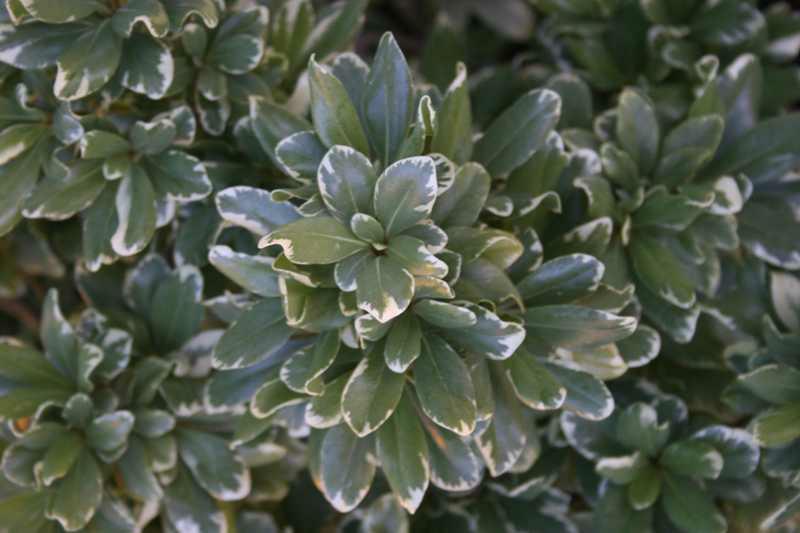Japanese pittosporum (Pittosporum tobira ‘Variegatum’)
Japanese pittosporum
Pittosporum tobira, commonly known as Japanese pittosporum, is a rounded, broadleaved evergreen shrub or small tree that is native to Japan, Korea and China. It is also sometimes commonly called mock orange or Austrian laurel. In the U.S., it is commonly grown in Florida, along the Gulf Coast and on the West coast. Plants typically grow as dense shrubs to 10-15’ tall, but may be kept smaller by pruning. In containers, they are usually grown much smaller (to 4’ tall). Obovate, leathery, evergreen, glossy, dark green leaves (1-5” long) with downward rolled margins are arranged in whorl-like patterns along the stems. Leaves are dull green beneath. Small 5-petaled pure white flowers (aging to creamy yellow) bloom in umbel-like clusters at the branch tips in spring (April – May). Flowers have the sweet fragrance of orange blossoms. Flowers give way to 3-valved green capsules that ripen to brown in fall but are often concealed by the foliage. Capsules split at maturity to reveal showy red seeds.
Genus name comes from the Greek words pitta meaning pitch and spora meaning seed in reference to the sticky resinous coating on the seed.
‘Variegata’ is a somewhat compact cultivar that grows to 5-10’ tall and features gray-green leaves with irregular creamy white margins.

Winter hardy to USDA Zone 9-10 where it is easily grown in average, slightly acidic, moderately fertile, medium moisture, well-drained soils in full sun to part shade. Best grown with some part afternoon shade. Avoid wet or poorly-drained soils where root rot is more likely to develop. Established plants have some drought tolerance. Regular trimming (often at the expense of flowering) may be needed to maintain plant form. Remove lower branching from an established plant to train as a small tree. In areas where not winter hardy, plants may be grown in containers that are overwintered indoors in sun rooms or greenhouses or as year-round houseplants. Indoor plants are best placed in bright light, but direct sun should be avoided. Reduce watering in winter.
| Hardiness zone | 9 - 10 |
| Sun light | Full sun to part shade |
| Water | Medium |
| Maintenance | Low |
No serious insect or disease problems. Aphids, scale, mealybugs and root-knot nematodes and whiteflies may occur. Watch for leaf spot, bacterial blight and crown/root rot.
Where winter hardy, grow in foundation areas, in borders, as a screen or hedge or in a mass planting. This plant may be trimmed and trained as a small tree that is effective near patios. Where not winter hardy, plants may be grown in containers that are overwintered in greenhouses or sunrooms. Houseplant.
| Common name | Japanese pittosporum |
| Botanical name | Pittosporum tobira 'Variegatum' |
| Plant type | Broadleaf evergreen |
| Family | Pittosporaceae |
| Hardiness zone | 9 - 10 |
| Water | Medium |
| Maintenance | Low |
| Flower color | White |
| Flowering period | April - May |
| Height | 10 - 15 ft. |
| Width | 12 - 18 ft. |